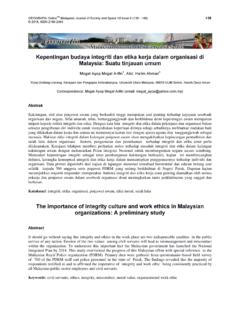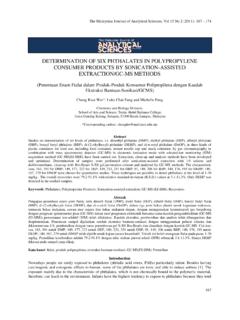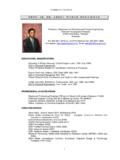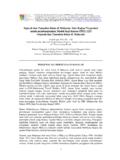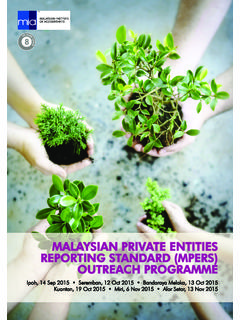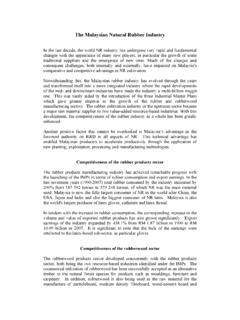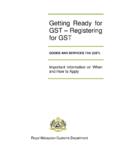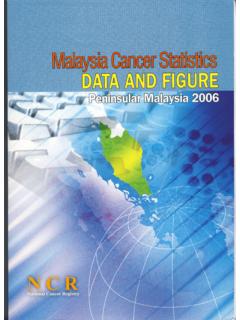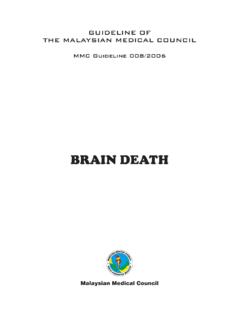Transcription of The food consumption and eating behaviour of Malaysian ...
1 GEOGRAFIA OnlineTM Malaysia Journal of Society and Space 8 issue 6 (157 - 165) 157 Themed Issue on The Management of Social-Ecological Change and Uncertainties in the Global Era 2012, ISSN 2180-2491 The food consumption and eating behaviour of Malaysian urbanites: Issues and concerns Noraziah Ali1, Mohd Azlan Abdullah1 1 School of Social, Development and Environmental Studies, Faculty of Social Sciences and Humanities Universiti Kebangsaan Malaysia Correspondence: Noraziah Ali Abstract food and the culture of eating of the Malaysian urban society has under gone so me for m o f transformation. This paper takes a closer look at the pattern of the Malaysian urbanites food consumption and eating behaviour , which w a s no longer anchored in the household. Instead, eating -out was practiced at the many food premises (including those operating 24 hours a day), available in the urban setting.
2 Based on secondary data from several case studies in Bandar Baru Bangi (Selangor), Jitra (Kedah) and Segamat (Johor) it was found that the practice of eating -out had become a trend among urban workers, students and even families because they could not go home to eat or b e c a u s e there w a s no food at home. Factors such as working away from home, working mothers, and food varieties (both local and international) served at many premises encouraged the practice of eating -out. Restaurants, food courts and food stalls w e r e servicing not only those who wanted to eat at meal times, but also those who wanted to enjoy food with friends/family members in a festive and relax manner. food caterers were also available to serve at formal functions (meetings, seminars) in offices and at home during religious and family occasions. However, l a c k o f consideration of nutrient contents, irregular eating time, poor food quality and premises cleanliness might expose the practitioner to health, social, familial and even safety risks.
3 Keywords: eating -out, food security, food premises, life style, local authority, urban society Introduction Current trends of urbanisation in Malaysia involve inreasing proportion of urban population through rural-urban migration, immigration, formation of new townships and expansion of urban boundaries or counter-urbanisation. Urbanisation has generated changing urban environment, especially in big cities and new townships, to cater the increasing demand by urban population for employment, transportation, social services, residential units, etc. Local authority as the governing body faces many challenges to cope with population increase and the ever changing pattern of lifestyle of the urban communities to achieve sustainability and quality of living. In the same context, food (and eating ) as the basic need for human survival is also affected likewise. Increasing demand for food is not only parallel with the increasing urban population but also involve changing eating behaviour and the urban landscape.
4 Nationally, Malaysia is also holding national fiest during celebrations for Muslim, Buddhist, Hindu and Christians which invole a big crowd of hundred thousand. The avenue is at open space and the place changes between states every year. Hence, eating - out has become a culture and c o o k e d f o o d i nd u s t r i e s are profitting on the new development. GEOGRAFIA OnlineTM Malaysia Journal of Society and Space 8 issue 6 (157 - 165) 158 Themed Issue on The Management of Social-Ecological Change and Uncertainties in the Global Era 2012, ISSN 2180-2491 This paper takes a closer look at the pattern of eating -out among the urban populations and related perspectives: the eateries, food businesses, local authorities and finally the implications of the eating phenomenon on the well-being of the urbanites. If food is not cook at home, then the alternative is food from the shops.
5 Hence, issues of food quantitiy and quality may pose risk to food security whereby eating behaviour lead to over eating , irregular eating , imbalanced diet and taking unclean o r contaiminated food . Discussion in this paper is based on several studies carried out in several Malaysian cities as examples, specifically pertaining to the Malay ethnic. Discussion and results The discussion is based on secondary data from several case studies carried out previously in Bandar Baru Bangi, Selangor, Jitra, Kedah and Segamat, Johor. Urbanisation patterns in Malaysia Table 1 shows population and urban population distribution by states in has the highest population size, follow by Johor and Perak. All states experience an increased in urban population, except Kelantan in the east cost of Peninsular Malaysia through natural growth and in-migration. Kuala Lumpur Federal Territory, Selangor, Pulau Pinang, Melaka, Johor and Perak are the most urbanized.
6 All these states are located in the west coast of Peninsular Malaysia which are the most developed region in Malaysia, especially those in and around the Klang Valley. Cities like Georgetown in Pulau Pinang, Ipoh in Perak, Shah Alam in Selangor and Johor Baharu in Johor, which are also states capital, are destinations of in-migrations and centers of socio-economic growth. Besides, many new townships, which are formed partly to counter-urbanized established cities are new destination of in-migration. Kuala Lumpur Federal Territory, Melaka and Penang Island in Pulau Pinang are experiencing urban conurbation as boundaries between neighboring towns expand and merge. Klang Valley is the biggest cosmopolitan as it situates Kuala Lumpur, Shah Alam, and other towns around Kuala Lumpur. The trend of urbanization has not only increases urban population, but has also brought changes in lifestyles.
7 High cost of living in the cities has driven families to seek more sources of income and more wives work, irrespective of educational attainment, either full time or part time. Hence, domestic arrangements have also changed with more families rely on foreign maids who stay in or on daily visits. Many families without domestic maids have to rely on services available in their neighborhood, such as nurseries, laundries and cooked food services. The structural and functional development in the urban areas reflects the changing lifestyles of the urban population. The local authorities in their local plan is subjected to build not only more residential units but also more shopping units or shopping complexes, open courts for food services and periodical markets (retailing). With regards to food premises, it is observed that cafe / cafeteria services are available at government offices, school and manufacturing industries, while restaurants and stall are operating in neighborhood and at the city centers, where variety of food premises and cooked food services are available.
8 GEOGRAFIA OnlineTM Malaysia Journal of Society and Space 8 issue 6 (157 - 165) 159 Themed Issue on The Management of Social-Ecological Change and Uncertainties in the Global Era 2012, ISSN 2180-2491 Table 1. Population and urbanisation distribution in Malaysia, 2000, 2005 & 2010 States Population (mil) 2000 2005 2010 % Urban population 2000 2005 2010 North: Kedah Perlis Pulau Pinang Perak Central States: Melaka N. Sembilan Selangor Kuala Lumpur Southern State: Johor East coast: Kelantan Pahang Terengganu East Malaysia: Labuan Sabah Sarawak Source: Ninth Malaysia Plan (2006 2010). Hence, the discussion on food quality and eating behavior among the urban population takes three related parties.
9 Firstly, the local authority who plan and developed shop units; secondly, the enterprises who conduct food services; and thirdly, the consumer or customers of the food services. The role of local authorities Local authorities roles can be divided into three categories. Firstly, to plan and develop infrastructures and amneties at urban centers, which include shop units for food services. Local authorities allocate spaces for food services to cater for new food enteprises. The objectives are to create economic opportunities and simultaneously cater for greater demand for food services from the public. Secondly, to produce licences to food operators through formal applications in accordance to shop units available and also handling courses for food operators (owner and workers) to ensure they comply to regulations (local act) before thay are allowed to operate their food business.
10 Thirdly, to ensure quality food services rendered to the public by setting rules and regulation for food operators and continued enforcement to protect the public from food containmenation. Enforcement unit of local authority work closely with local Health Deparment in this task. eating area is stricly within the premise but many food operators use road outside their premise at night as open eating area. The latest option taken is to grade food premises as A (good), B (moderate with caution) and C (poor with closure order) as in Table 2. The grade is not only to ensure and permit clean food operators to operate, but also as an indicator to eateries of the quality of the premises and the food served. GEOGRAFIA OnlineTM Malaysia Journal of Society and Space 8 issue 6 (157 - 165) 160 Themed Issue on The Management of Social-Ecological Change and Uncertainties in the Global Era 2012, ISSN 2180-2491 In practice, the local authority is facing several issues.
